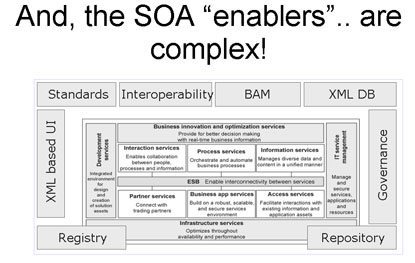Do we really need this complexity?

My first post on the Progress SOA Blog! This gives me jitters... All the writing till now was somehow different. There was a carefree attitude to that writing. When I wrote my book (nearly 40% of the book on SOA approach to Integration), or when I write my personal blog posts, I never had to worry about the impact. Now as informal as this may be, at the end of the day it does have a non-personal tone. Even so, I am excited about this. :-)
My views essentially are reflections on the software services and SI ecosystem and what/how they use technologies in the integration solutions space. Lately, I have been also quite caught by the SaaS/PaaS promise in the SOA context - even if I am quite skeptical about the hyped up value.
<p Recently, I was speaking on this topic at the IndicThreads conference on Java at Pune. I included a slide on the complexity of SOA. While in my flow I was using it to talk about some of the SOA enablers in our SOA portfolio in simplifying this complexity, the presentation and some following questions triggered a thought... How much of this does the industry actually need? Aren’t these more of a fringe scenario that needs all of this? Isn’t the REST vs. SOAP argument a good case in point? 80+% of the world needs only basic remote service mechanism. While REST more than suffices here, this basic need from the world is but just a small part of SOAP! So, who needs the rest?
Recently, I was speaking on this topic at the IndicThreads conference on Java at Pune. I included a slide on the complexity of SOA. While in my flow I was using it to talk about some of the SOA enablers in our SOA portfolio in simplifying this complexity, the presentation and some following questions triggered a thought... How much of this does the industry actually need? Aren’t these more of a fringe scenario that needs all of this? Isn’t the REST vs. SOAP argument a good case in point? 80+% of the world needs only basic remote service mechanism. While REST more than suffices here, this basic need from the world is but just a small part of SOAP! So, who needs the rest?
The simplicity of REST is stark - at least when compared to the extremely unwieldy SOAP and its numerous accompanying specifications. And it is further compounded by all the WS* standards. Making things worse are frameworks for frameworks such as WS-Policy. WS-policy is a framework that layers on SOAP. And there are other standards that use WS-Policy as the basis for definition. In effect, we have XML over HTTP, on which is defined the SOAP standard, on SOA is the WS-Policy. And on WS-Policy are standards such as WS-S & WS-T. Phew!
Now compare this with REST - that actually has no other specification other than HTTP itself! Granted, this seriously limits what we can do with REST. But lets accept it - the world needs mostly ONLY the likes of just REST and only a very small fraction needs the multiple layers of specifications such as SOAP! Even in the SOAP land this is very well captured in how AXIS evolved - trying to keep pace with the rather haphazard offshoots of SOAP. And now there is CXF whose basic premise is to simplify SOAP and Web Services. From the word go, it has embraced the simplicity and is also trying to be more about services and less about SOAP. In the spirit of the latter, CXF also supports REST right off the bat.
I see 2009 as year where this simplicity is bound to get consolidated. The more simpler and easier the SOA framework becomes, the more it will get accepted. FUSE open sources SOA framework will be one very serious contender in this space. Functionally as complete as any other SOA solution, yet lean and mean with a good set of tools. Watch out for more in the months to come.

